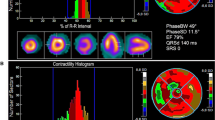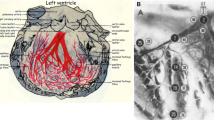Abstract
Background
Abnormal electrical activation may cause dyssynchronous left ventricular (LV) contraction. In this study, we characterized and analyzed electrical and mechanical dyssynchrony in patient with left bundle branch block (LBBB) and healthy controls.
Methods
Myocardial perfusion imaging (MPI) data from 994 patients were analyzed. Forty-three patient fulfilled criteria for LBBB and 24 for controls. Electrical activation was characterized with vector electrocardiography (VECG) and LV function including mechanical dyssynchrony with ECG-gated MPI phase analysis.
Results
QRS duration (QRSd; r = 0.69, P < .001) and a few other VECG parameters correlated significantly with phase bandwidth (phaseBW) representing mechanical dyssynchrony. End-diastolic volume (EDV; r = 0.59, P < .001), ejection fraction and end-systolic volume correlated also with phaseBW. QRSd (β = 0.47, P < .001) and EDV (β = 0.36, P = .001) were independently associated with phaseBW explaining 55% of its variation. Sixty percent of patients with LBBB had significant mechanical dyssynchrony. Those patients had wider QRSd (159 vs 147 ms, P = .013) and larger EDV (144 vs 94 mL, P = .008) than those with synchronous LV contraction. Cut-off values for mechanical dyssynchrony seen in patients with LBBB were QRSd ≥ 165 ms and EDV ≥ 109 mL.
Conclusions
Despite obvious conduction abnormality, LBBB is not always accompanied by mechanical dyssynchrony. QRSd and EDV explained 55% of variation seen in phaseBW. These two parameters were statistically different between LBBB cases with and without mechanical dyssynchrony.



Similar content being viewed by others
Abbreviations
- LBBB:
-
Left bundle branch block
- MPI:
-
Myocardial perfusion imaging
- VECG:
-
Vector electrocardiography
- SPECT:
-
Single photon emission computerized tomography
- QRSd:
-
QRS duration
- EDV:
-
End-diastolic volume
- phaseBW:
-
Phase bandwidth (phase analysis parameter describing mechanical dyssynchrony)
- LBBBnor :
-
Left bundle branch block patient with normal (synchronous) left ventricular contraction
- LBBBabn :
-
Left bundle branch block patient with abnormal (dyssynchronous) left ventricular contraction
References
Strauss DG, Selvester RH, Wagner GS. Defining left bundle branch block in the era of cardiac resynchronization therapy. Am J Cardiol. 2011;107:927–34.
Vassallo JA, Cassidy DM, Marchlinski FE, Buxton AE, Waxman HL, Doherty JU, et al. Endocardial activation of left bundle branch block. Circulation. 1984;69:914–23.
Littmann L, Symanski JD. Hemodynamic implications of left bundle branch block. J Electrocardiol. 2000;33:115–21.
Rodriguez LM, Timmermans C, Nabar A, Beatty G, Wellens HJ. Variable patterns of septal activation in patients with left bundle branch block and heart failure. J Cardiovasc Electrophysiol. 2003;14:135–41.
Fahy GJ, Pinski SL, Miller DP, McCabe N, Pye C, Walsh MJ, et al. Natural history of isolated bundle branch block. Am J Cardiol. 1996;77:1185–90.
Samol A, Klotz S, Stypmann J, Bruns HJ, Houben R, Paul M, et al. QRS integral: An electrocardiographic indicator of mechanical interventricular asynchrony. J Electrocardiol. 2010;43:242–50.
van Deursen CJ, Vernooy K, Dudink E, Bergfeldt L, Crijns HJ, Prinzen FW, et al. Vectorcardiographic QRS area as a novel predictor of response to cardiac resynchronization therapy. J Electrocardiol. 2015;48:45–52.
Gimelli A, Liga R, Giorgetti A, Favilli B, Pasanisi EM, Marzullo P. Determinants of left ventricular mechanical dyssynchrony in patients submitted to myocardial perfusion imaging: A cardiac CZT study. J Nucl Cardiol. 2016;23:728–36.
Chen J, Garcia EV, Folks RD, Cooke CD, Faber TL, Tauxe EL, et al. Onset of left ventricular mechanical contraction as determined by phase analysis of ECG-gated myocardial perfusion SPECT imaging: Development of a diagnostic tool for assessment of cardiac mechanical dyssynchrony. J Nucl Cardiol. 2005;12:687–95.
Tarvainen MP, Niskanen JP, Lipponen JA, Ranta-Aho PO, Karjalainen PA. Kubios HRV-heart rate variability analysis software. Comput Methods Programs Biomed. 2014;113:210–20.
Kors JA, van Herpen G, Sittig AC, van Bemmel JH. Reconstruction of the Frank vectorcardiogram from standard electrocardiographic leads: Diagnostic comparison of different methods. Eur Heart J. 1990;11:1083–92.
Cortez D, Sharma N, Devers C, Devers E, Schlegel TT. Visual transform applications for estimating the spatial QRS-T angle from the conventional 12-lead ECG: Kors is still most Frank. J Electrocardiol. 2014;47:12–9.
Cortez DL, Schlegel TT. When deriving the spatial QRS-T angle from the 12-lead electrocardiogram, which transform is more Frank: Regression or inverse Dower? J Electrocardiol. 2010;43:302–9.
Schreurs CA, Algra AM, Man SC, Cannegieter SC, van der Wall EE, Schalij MJ, et al. The spatial QRS-T angle in the Frank vectorcardiogram: Accuracy of estimates derived from the 12-lead electrocardiogram. J Electrocardiol. 2010;43:294–301.
Ray D, Hazra S, Goswami DP, Macfarlane PW, Sengupta A. An evaluation of planarity of the spatial QRS loop by three dimensional vectorcardiography: Its emergence and loss. J Electrocardiol. 2017;50:652–60.
van Deursen CJ, Vernooy K, Dudink E, Bergfeldt L, Crijns HJ, Prinzen FW, et al. Vectorcardiographic QRS area as a novel predictor of response to cardiac resynchronization therapy. J Electrocardiol. 2015;48:45–52.
Casale PN, Devereux RB, Alonso DR, Campo E, Kligfield P. Improved sex-specific criteria of left ventricular hypertrophy for clinical and computer interpretation of electrocardiograms: Validation with autopsy findings. Circulation. 1987;75:565–72.
Angeli F, Verdecchia P, Iacobellis G, Reboldi G. Usefulness of QRS voltage correction by body mass index to improve electrocardiographic detection of left ventricular hypertrophy in patients with systemic hypertension. Am J Cardiol. 2014;114:427–32.
Sokolow M, Lyon TP. The ventricular complex in left ventricular hypertrophy as obtained by unipolar precordial and limb leads. 1949. Ann Noninvasive Electrocardiol. 2001;6:343–68.
Nichols KJ, Van Tosh A, Siddiqi S, Chen J, Garcia EV, Palestro CJ, et al. Gated myocardial perfusion SPECT asynchrony measurements in patients with left bundle branch block. Int J Cardiovasc Imaging. 2009;25:43–51.
Kirk JA, Kass DA. Cellular and molecular aspects of dyssynchrony and resynchronization. Card Electrophysiol Clin. 2015;7:585–97.
Galeotti L, van Dam PM, Loring Z, Chan D, Strauss DG. Evaluating strict and conventional left bundle branch block criteria using electrocardiographic simulations. Europace. 2013;15:1816–21.
Strauss DG. Differentiation between left bundle branch block and left ventricular hypertrophy: Implications for cardiac resynchronization therapy. J Electrocardiol. 2012;45:635–9.
Emkanjoo Z, Esmaeilzadeh M, Mohammad Hadi N, Alizadeh A, Tayyebi M, Sadr-Ameli MA. Frequency of inter- and intraventricular dyssynchrony in patients with heart failure according to QRS width. Europace. 2007;9:1171–6.
Baldasseroni S, Opasich C, Gorini M, Lucci D, Marchionni N, Marini M, et al. Left bundle-branch block is associated with increased 1-year sudden and total mortality rate in 5517 outpatients with congestive heart failure: A report from the Italian network on congestive heart failure. Am Heart J. 2002;143:398–405.
Hess PL, Shaw LK, Fudim M, Iskandrian AE, Borges-Neto S. The prognostic value of mechanical left ventricular dyssynchrony defined by phase analysis from gated single-photon emission computed tomography myocardial perfusion imaging among patients with coronary heart disease. J Nucl Cardiol; 2016. p. 25.
Trimble MA, Borges-Neto S, Honeycutt EF, Shaw LK, Pagnanelli R, Chen J, et al. Evaluation of mechanical dyssynchrony and myocardial perfusion using phase analysis of gated SPECT imaging in patients with left ventricular dysfunction. J Nucl Cardiol. 2008;15:663–70.
Neto NR, Fonseca GC, Torres GG, Pinheiro MA, Miranda GB. Correlation between electrocardiographic features and mechanical dyssynchrony in heart failure patients with left bundle branch block. Ann Noninvasive Electrocardiol. 2011;16:41–8.
Rautaharju PM, Prineas RJ, Wood J, Zhang ZM, Crow R, Heiss G. Electrocardiographic predictors of new-onset heart failure in men and in women free of coronary heart disease (from the Atherosclerosis in Communities [ARIC] Study). Am J Cardiol. 2007;100:1437–41.
Kors JA, Kardys I, van der Meer IM, van Herpen G, Hofman A, van der Kuip DA, et al. Spatial QRS-T angle as a risk indicator of cardiac death in an elderly population. J Electrocardiol. 2003;36:113–4.
Zhang ZM, Rautaharju PM, Prineas RJ, Whitsel EA, Tereshchenko L, Soliman EZ. A wide QRS/T angle in bundle branch blocks is associated with increased risk for coronary heart disease and all-cause mortality in the Atherosclerosis Risk in Communities (ARIC) Study. J Electrocardiol. 2015;48:672–7.
Tian Y, Zhang P, Li X, Gao Y, Zhu T, Wang L, et al. True complete left bundle branch block morphology strongly predicts good response to cardiac resynchronization therapy. Europace. 2013;15:1499–506.
Azizian N, Rastgou F, Ghaedian T, Golabchi A, Bahadorian B, Khanlarzadeh V, et al LV Dyssynchrony Assessed With Phase Analysis on Gated Myocardial Perfusion SPECT Can Predict Response to CRT in Patients With End-Stage Heart Failure. Res Cardiovasc Med 2014;3.
Boogers MM, Van Kriekinge SD, Henneman MM, Ypenburg C, Van Bommel RJ, Boersma E, et al. Quantitative gated SPECT-derived phase analysis on gated myocardial perfusion SPECT detects left ventricular dyssynchrony and predicts response to cardiac resynchronization therapy. J Nucl Med. 2009;50:718–25.
Bertaglia E, Migliore F, Baritussio A, De Simone A, Reggiani A, Pecora D, et al Stricter criteria for left bundle branch block diagnosis do not improve response to CRT. Pacing Clin Electrophysiol 2017.
Disclosure
The research was financially supported by Finnish Foundation for Cardiovascular Research. The author Saara Sillanmäki has had educational support from GE Healthcare. Other researchers have nothing to declare.
Author information
Authors and Affiliations
Corresponding author
Additional information
The authors of this article have provided a PowerPoint file, available for download at SpringerLink, which summarizes the contents of the paper and is free for re-use at meetings and presentations. Search for the article DOI on SpringerLink.com.
Electronic supplementary material
Below is the link to the electronic supplementary material.
Rights and permissions
About this article
Cite this article
Sillanmäki, S., Lipponen, J.A., Tarvainen, M.P. et al. Relationships between electrical and mechanical dyssynchrony in patients with left bundle branch block and healthy controls. J. Nucl. Cardiol. 26, 1228–1239 (2019). https://doi.org/10.1007/s12350-018-1204-0
Received:
Accepted:
Published:
Issue Date:
DOI: https://doi.org/10.1007/s12350-018-1204-0




